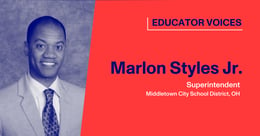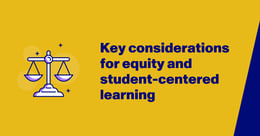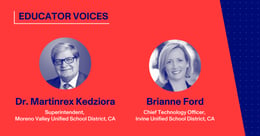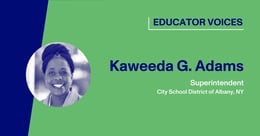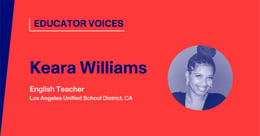
Designing With an Accessibility Lens: Benefits of Assistive Technology
Christopher Bugaj is the host of a podcast, a district assistive technology specialist, a speech-language pathologist, an ISTE author, an app author, an international presenter, and an online mentor. Paper’s CEO, Philip Cutler, met him last year at the MassCUE conference, where Chris gave a talk about how assistive technology leads the way towards innovations applicable to all. Phil reached out to Chris a few weeks ago to be a part of our interview series, and the Paper team had the pleasure of talking to him on April 15.
In this interview, edited and condensed for clarity, Chris gives a detailed account of the importance of designing with an accessibility lens, teaching our youth about accessible practices, and low-tech learning activities during school closures. He also expands on his 2019 MassCUE talk, about how many of today’s mainstream technologies were originally developed as accommodations for people with disabilities.
How about we start with your background?
I'm a speech-language pathologist, but I've been working in the same school district in Northern Virginia for 21 years now, and about three or four years into my career, they asked me to start the assistive technology team. So it was me and a handful of other educators sitting here deciding what the policies and procedures should be, what assistive technology is, what it can be. Now, I think of myself as an inclusive design facilitator, who has worked in assistive technology, who has a background in speech-language pathology.
What we've learned over the years working with students and teachers, specifically with students with disabilities, is that the technology that is often used for students with disabilities is something that blossoms into stuff that can be used with everybody. So much of the technology we have today, the first people who were using it were people with disabilities.
Thanks for sharing that. Would you say your role is different now with the shift to distance learning?
One hundred percent, and it's never been busier. I hate to say this because there's so much tragedy happening right now and so much fear, but a big silver lining of this whole thing is the amount of accessibility conversations and Universal Design conversations we've been having. There's a whole block of teachers who I think they said: "Okay, we're doing distance learning. Let me just do what I was doing in the classroom and try to move that over into this online space." I think the teachers that do that will probably struggle. But teachers who will be more successful with remote learning are those that have already been designing things from the point of: "What if I always made my stuff so the text can be read out loud, and my videos had captions, and kids had options about how they could choose to experience the content?"
And so when I design my educational experience for the kids to engage in their learning, I'm providing them options that they get to choose from. So I'm busier than ever because more teachers are trying to figure this out. And so they're like, "Oh, yeah, I should put captions on my videos" and in the past, they may have made a video, and they were not thinking about "Who might I have next year that might use this video or who's the people at the students' homes that will be supporting them?".
And we don't know who might be supporting them in their home. Their parents or grandparents might have a disability, so we have to design the instruction in an accessible way because you don't really know. There is also the fact that there are kids that don't have a disability; they're not identified. But maybe they could be identified, they kind of fall in the middle.
If you design things with an accessibility lens, then one, you don't have to redesign things, and two, you catch all those kids that may have been falling in the cracks.
Yes, we agree that the silver lining in all of this is that accessibility and equity are on the front line of many conversations. Could you elaborate on some initiatives your district is doing right now to support students at home?
Like in many other districts, when our school district started to close down, we put up resources for parents to look at with no obligation. We have a website called Continuity of Education where you can find these digital resources, and we decided to put all these accessibility tools at the forefront.
We also use the term "usability" because "accessibility" often brings forth this mindset of "well, that's for someone with a disability. I'm going to skip right over that resource because I don't have one of those."
You know, as far as we know, my own kids don't have a disability, but they use these tools all the time. How often do I use word-prediction when I'm texting? All the time. Word prediction is built into our Gmail now. So it's not for just kids with disabilities, but it's for all kids.
We noticed your tweets with photos and videos have image descriptions. How would you say we can get more people to adopt such inclusive practices, and see it as a necessity rather than just something nice to do?
Yeah, I think there are three real ways to entice people to do this. One is that if you make it easy enough, people will do it. Two is for companies to recognize that the population of people with disabilities is roughly 12-13 percent. If you don't make your product accessible, you're leaving out 12 to 13% of a potential market that could be benefiting from you. And even if you don't appeal to that market, everyone knows somebody with a disability loves somebody with a disability, cares for someone with a disability.
And then the third way is understanding that innovation comes from disability. I talked about this in my MassCUE talk, and it's illustrated in my book as well. So much of the innovation that has happened and has become mainstream for us now started with people with disabilities. I already talked about word-prediction and there are a few other examples of this. Once upon a time, we used to use these things called touch windows that you would put over CRT monitors. These were so that people who couldn't control the mouse could maybe touch a screen. And now we all have phones that are touchscreens. There's also speech-to-text. How often do you talk into your computer or your phone, and it types out the text for you? But who are the first people that that was for? People who couldn't use a keyboard, right?
So, if your design considers people with disabilities, it helps you make your product better for everybody and get you thinking about innovative practices and solutions.
Those are such great points! There’s also probably a lack of awareness around these inclusive practices. Some people don’t even know that you can put image and video descriptions on your social media.
Yeah, absolutely. A couple thoughts there. If you have an iPhone, in the most recent update, they moved “Accessibility” that was buried in the settings to the front page, and now it makes it a little bit easier to access these tools. People now realize that they can make the text bigger or that they can have their text read out loud. That's number one. And number two is that our school district has a sort of a mantra: “Empowering students to make meaningful contributions to the world.” And what that means is we're not only preparing them to make meaningful contributions when they graduate, but right now students can make meaningful contributions.
So in the larger scope of education, there's this movement towards project-based learning and personalized learning. The idea that the students will have some sort of project that they work on based on a problem they're trying to solve. Once they figure out whatever their problem is and they figure out solutions for it, they usually come up with some sort of product. Right? That's the project in project-based learning. It’s some sort of product that you're putting out.
Well, one of the things we can do right now is to help kids and students understand that: "My product needs to be accessible. If my final product is a video, it's got to have captions. If my final product is a brochure, I got to be able to make it so that text can be read out loud, and the images have text behind them, so if someone's blind, they can see them."
If we can teach the kids right now while they're making contributions, then the next generation won't be playing the catch-up that our generation is now. They'll be just realizing we're in a diverse world with diverse needs.
We completely agree with you. Is there anything else that you’d like to share with us about this subject?
I think one of the inequities that have come out is that some people have the internet, and some people don't, and that is often not by choice. Meaning, they live and work in an area that does not have internet access.
And so we have to be thinking about some low-tech strategies that might be able to help them. Something assistive technology people talk about is we often equate ourselves to the MacGyver. It's this old TV show where MacGyver would solve problems with the things he had in his environment, and that's sort of the same thing that we think of here. Like, "What does the student have available to them in their house? What do parents have available in their house that will help with this learning?"
So a couple of quick strategies there that will immediately help just about anybody is number one, turn the captions on if your kids are going to watch TV. Chances are your kids are going to have more screen time than ever right now, and everyone's going to feel some guilt about that. Well, if you turn the captions on that lessens that guilt a little bit because research suggests that turning the captions on helps people become better readers, especially for the English language Learners population. So definitely turn the captions on. It doesn't hurt anybody, and it can only help.
The second thing is that there are lots of literacy-fun activities you can do that are low-tech. If you have chalk around the house, go out and write words on your driveway or on the street. So people in your neighborhood can drive by and see positive messages, but you can also practice your spelling.
You can build sentences with Legos and label different colored Legos. For example, all the green Legos are verbs, and all the yellow ones are pronouns. That kind of engaging stuff can make learning fun without technology and can make it accessible to a wide variety of people.
More from Christopher Bugaj
To learn more about Chris and to keep up with his incredible work, make sure to check out his website and to follow him on Twitter. Chris is the co-host of the Talking with Tech podcast, where he and his co-host Rachel discuss supporting complex communication needs with alternative and augmentative communication and assistive technology. Chris and his wife Melissa also produce the popular Night Light Stories podcast, which features free, original stories for children of all ages.

